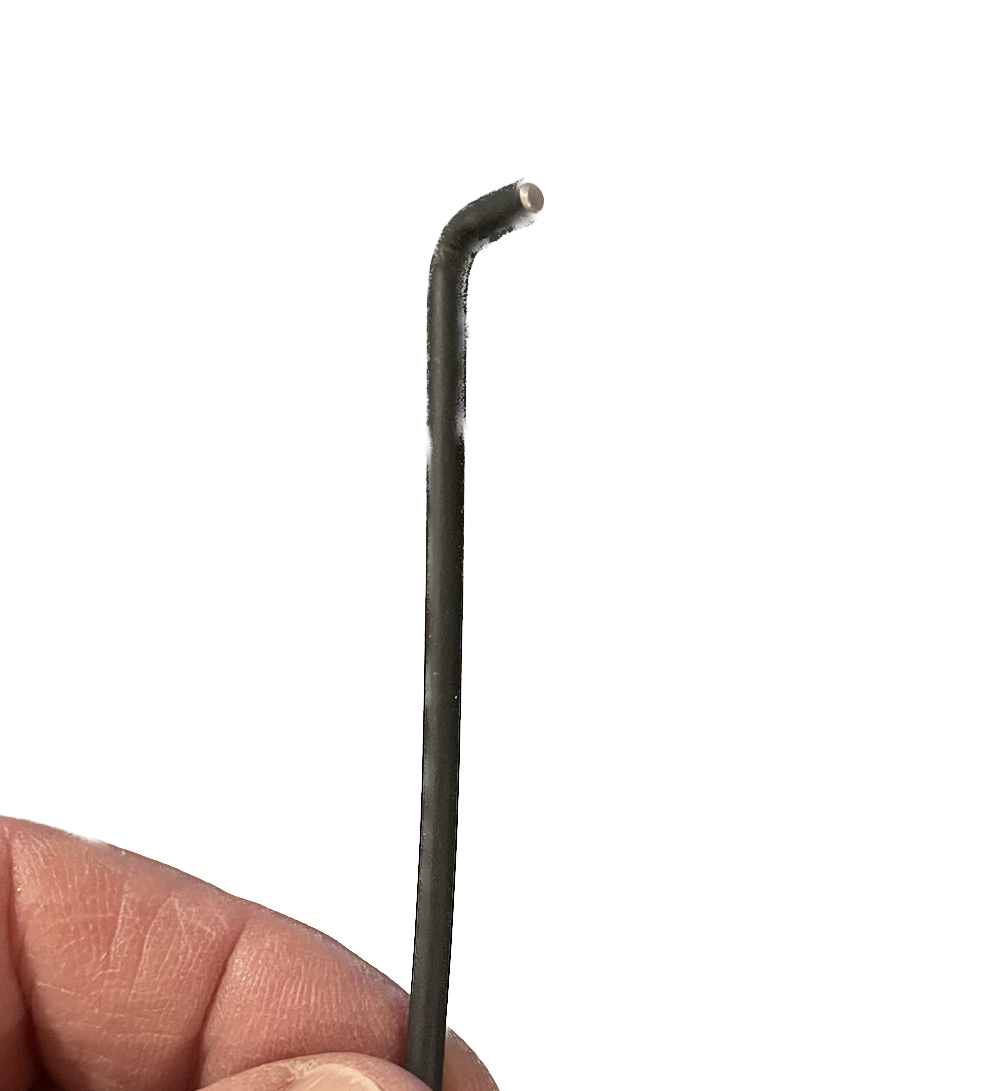The Supatrac Blackbird Farpoint—A Tonearm Like No Other
a genuine mechanical and sonic breakthrough
We live in a clickbait, hype-infested, hyperbolic, anything goes commercial world—even when it comes to medicine. You can buy a brush-on cure for "toe fungus". Of course, there's no such thing as "toe fungus". There's toe nail fungus that no brush on liquid cures but these telemarketing geniuses have conflated the two and are probably raking it in from people who think they can now brush away gross looking, thick yellow, fungus-infested toe nails. You can't! But in today's de-regulated, free-wheeling world, no government agency will call the scammers out or demand they offer proof of their claims.
A company called Roman has been telemarkeing E.D. products for a few years (E.D. does not stand for Elusive Disc) but now they are selling some kind of miracle "pen" with a sharp point you jab into your gut and it supposedly solves a whole range of problems, including overeating. A zoftig woman in the television ad jabs herself and says "Who would have thought that a tiny prick could be so powerful?" Have you seen that? I'm not making it up nor was that a political quip.
Over in our world of high performance audio, the hype runs long and deep. A two way box loudspeaker is declared "a game changer". This month's "best I've ever heard" product is replaced by next month's "best I've ever heard" product. Breathless magazine cover headlines end with exclamation points. The race to be pull-quoted in an audio manufacturer's print ad and establish name visibility runs deep in the audio press reviewer backwaters. I think you know where this is going.
I've tried over the past almost forty years of reviewing to avoid the endless hype trap and I've definitely not added purposeful pull quote sentences that any halfway perceptive reader can ferret out while reading a review, certain it will appear a few months later in the manufacturer's print advert.
A few products over the years have received from me the full gust of hype wind—among them the Continuum Caliburn turntable, the SAT and Kuzma 4 Point tonearms (especially the Safir), the Ortofon A90 and Lyra Atlas cartridges, the darTZeel NHB 18NS and 468 amplifiers, and more recently the CH Precision P10 phono preamp. These are all costly assaults on "state of the art" technology and performance, and in retrospect I'm satisfied those were all good calls! No regrets. Buyers agree.
The same is true of budget or modestly priced products to which I've given enthusiastic "for the money" type reviews—never claiming that a low priced product matches or bests the performance of the finest I've heard. Looking back, two moderately priced loudspeakers I owned and endorsed as extra special, the Spica TC-50 and Audio Physic Virgo II, were every bit as great as I thought and both are still worth buying and owning—I regularly hear from owners, original and new. That is very gratifying! Which brings me to...
The Supatrac Blackbird Farpoint
I first spotted the Supatrac Blackbird tonearm at Munich High End 2023 in the Start Up area where dreamers, schemers—some barely in business— get a chance to demonstrate and show off their new products. I was told to go there by Takumi turntable designer Rik Stoet. Otherwise I might have missed it. Thank you Rik!

There I encountered Richard Braine, a physicist with too much time on his hands, who invented this tonearm. Please watch this video encounter I had with him at the show. You'll enjoy the repartee and learn a great deal about this absolutely unique patented (* UK patent 2599073, international patents pending) design.
The "Farpoint" modification was announced in the fall of 2023 and consists of "...a centimetre pivot distance increase with a corresponding increase in arm length on the same turntable. Hence the name, ‘Farpoint’. Farpoint tone-arms incorporate reinforcement at the critical headshell and thrustbox junctions. The arm pillar is stiffer and more universal, allowing each Blackbird tone-arm to be adapted to a wider range of turntable mounts. Suspension and lean (‘azimuth’) adjustments have been separated so that hot-swapping tone-arms is more easily achieved without the need to re-adjust the suspension."
Let me again cover what's in that video in case you don't watch, and what makes this arm truly unique. It's easy to say "it's a sideways unipivot" (the "SUPA" in SUPATRAC stands for Sideways UniPivot Arm) but somewhat more difficult to understand. If you're familiar with the Well-Tempered arm, or even if you are not, the latest version looks like this:

The "unipivot" as such is at the top with the arm suspended on monofilament. It's weighted to keep it from "blowing in the wind" and the weight sits partially in a silicone trough, which both stabilizes and adds tension to the hanging assembly.
The Supatrac Blackbird is similarly "hung" as you can see in this screen shot from the above video (the arm wires are also visible and must be carefully tucked to avoid interference with arm movement). Mr. Braine pulled the arm forward to show it:
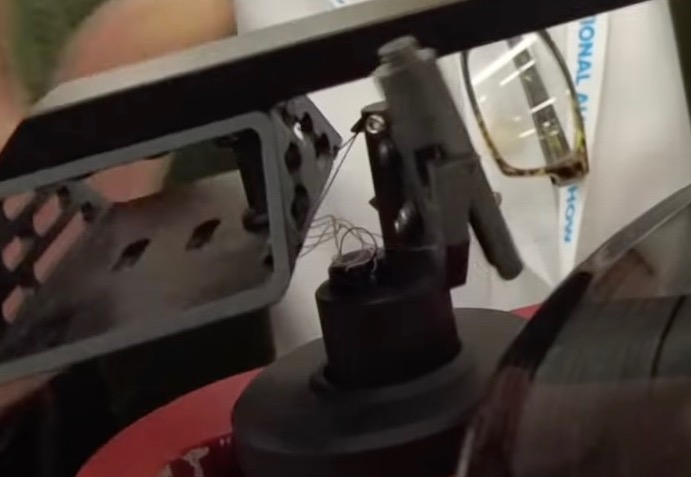
You can see the black thread (which he says is super strong and will not break unless you really abuse it) hanging from a juncture at the top of the pillar, and going into either side of the structure he calls the "Thrustbox". The "straddling" arrangement provides lateral stability. In this aspect the design resembles the Well Tempered, but you can see the sideways unipivot point below, machined at the end of a threaded bolt screwed into and protruding from the front of the main pillar. With Braine's backward tug reversed, the arm and cartridge weight pulls the assemblage forward pressing the point against the plate that forms the Thrustbox's forward surface. The point of the string's hanging junction extends through a plate opening, leaving the string junction vertically aligned with the pivot point, producing a remarkably rigid and stable arrangement of metal and string.
When a record plays, the forward pull produced by groove friction and modulation enhances the mechanical connection between the plate and point. The higher the groove modulation, the more secure the connection becomes! A small tiny supplied cylindrical magnet affixed to the bolt end of the bearing screw further securing and strengthening the contact.
Think about this arrangement compared to a standard unipivot arm, where the groove energy works at a ninety degree angle to the pivot, actually pulling the point forward in the cup in which it sits. This is far more secure and makes so much more sense! Imagine the stability and security of this system and think about all of the arm's groove related activity originating at that single, rear facing horizontal point.
Braine points out that this arrangement avoids the inevitable "cup scrubbing" and/or "chatter" produced by bearing points residing in a jeweled cup or cups. The result he avers is far superior performance in the time domain because the assemblage remains fixed rather than microscopically straying.
What's more, the bearing pivots just below record level, which means that highly modulated musical passages produce a slightly increased downward torque just when it's needed as described here:
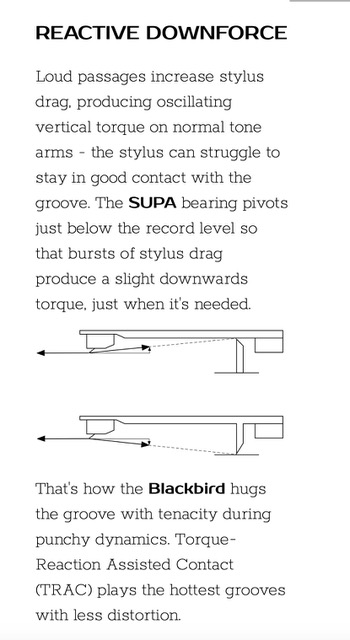
Rigid Armtube
Two bonded together pultruded carbon fiber tubes form the arm wand, with the head shell area reinforced with aluminum. The tube clamps firmly to the "Death Star" thrust box, which includes a part called the "Vader" (the vader bolt shortens or lengthen the "hoists" that determine where the pivot sits on the plate). It looks like Darth's helmet (Braine is obviously a Star Wars fan) as does a SAAB two-stroke engine air filter container.
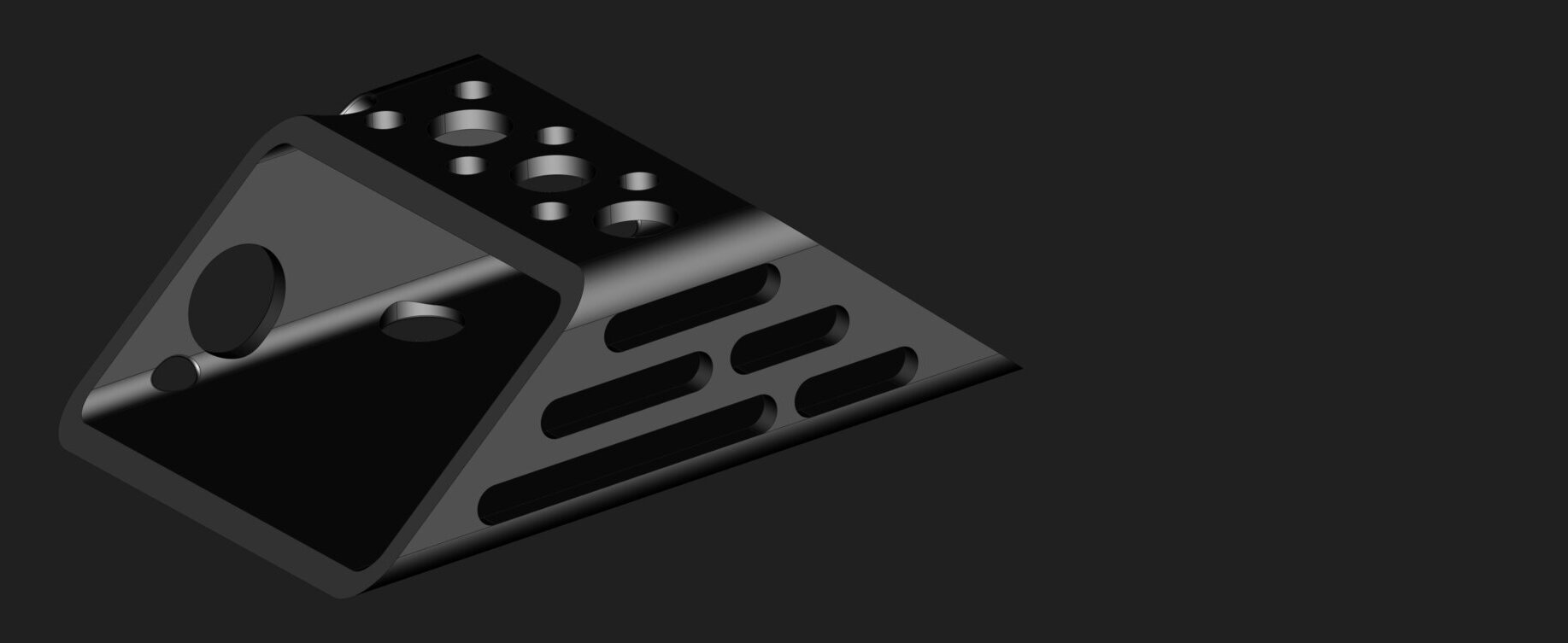 "Death Star" Thrust Box
"Death Star" Thrust Box
 Vader
Vader
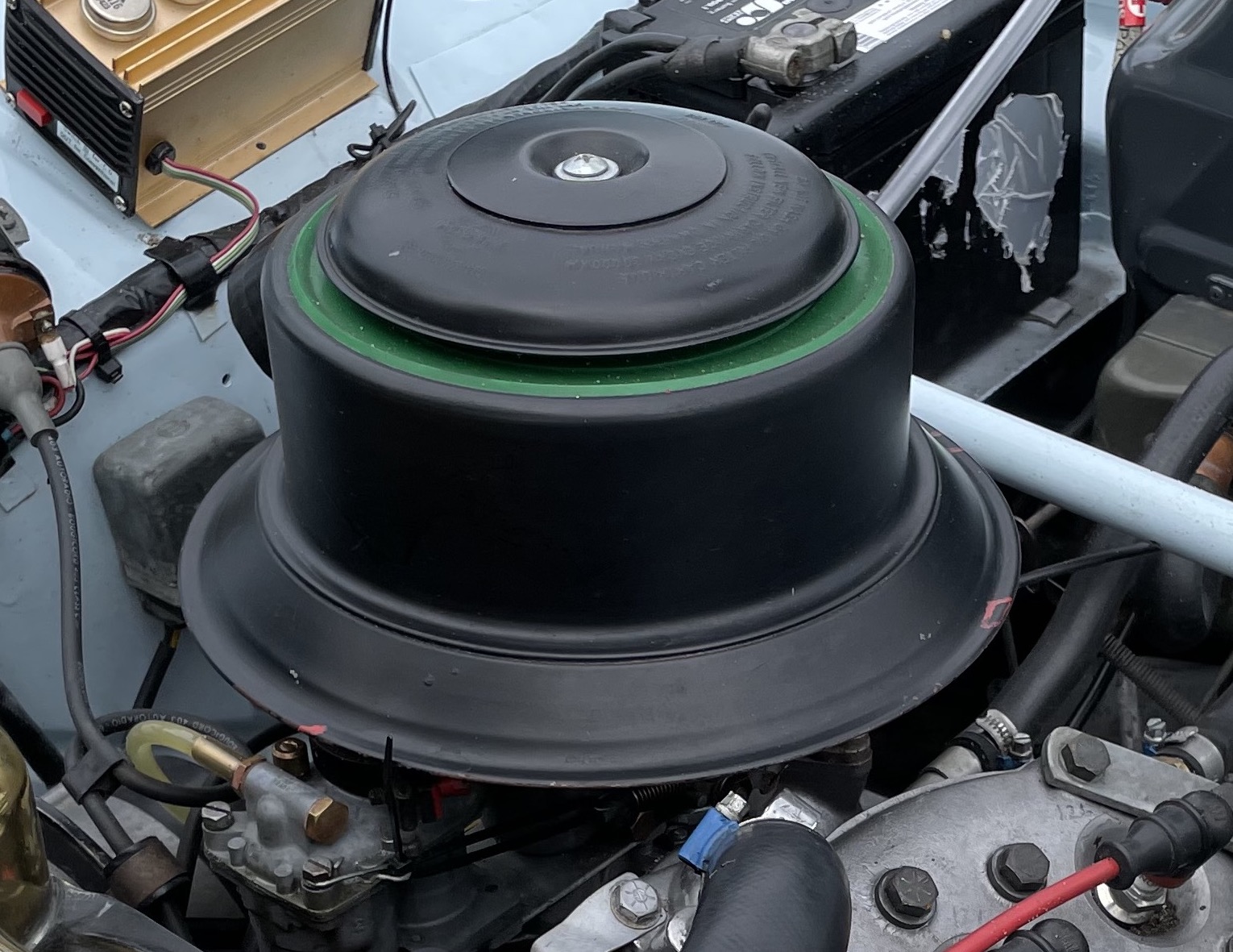 Saab 2 stroke engine air cleaner structure
Saab 2 stroke engine air cleaner structure
The head shell area is reinforced with aluminum, all forming according to Supratrac, "...an exceptionally inflexible and dead structure with tennis-racquet-class strength-to-weight ratio."
Tracking force is set using supplied rectangular magnets that fix to the thrust box and are slid fore and aft. They can be placed within or under the thrust box rear. Anti-skating is set via a pivoted cylinder (called in the instructions the "bias rotor") actuated by a monofilament attached to a fixed point on one end and through the "bias rotor" on the other. The line's tautness determines where the bias rotor begins to apply anti-skating and where it ends. A threaded screw set into the "bias rotor" determines the amount of applied bias. Screwing the screw out, adds weight and applies more anti-skating force.
Azimuth, which the instructions call "lean" can be set two ways: one is by sliding the magnetic counterweights left and right, which if you're not really careful can change tracking force. The other way (preferred) is by adjusting the length of the hoist thread on either side of the arm. The procedure calls for sliding the arm laterally while rotating it around the hoist hook in a see-saw motion. If that's not clear, it's kind of like adjusting your shoelace ends to be the same length before you tie them.
Set Up Twists
I'm going to relate to you my experience setting up this arm, even at the expense of perhaps seeming a bit dim. Though I'm going more deeply into the set-up details than usual, I think you should know about them before you consider buying a Blackbird.
The more experience you've had setting up tonearms, the more difficult you might find setting this one up. At least I did. That's partly because of how different it is from all others, partly because of the instructions, and partly because of the way the parts (some of which are mysterious) are packed, though they do come in a nice hard case. As I've frequently written, an inventor should never write his or her own product's instruction manual!
Confronted by such an unusual design, I carefully followed the instructions. No assumptions, no improvisation, no getting ahead of what's on the written page. I need to say here that the designer has made an excellent effort to produce a well-illustrated and complete setup and maintenance manual, but it misses badly in a few key areas, the main one below in boldface.
Installing the cylindrical arm base is simple enough. It's compatible with Linn, SME, Reg, Jelco, VPI and other arm mounts. Supatrac can supply many base variations to meet your particular needs. The OMA K3 required a raised base but otherwise no problems. Pages two and three show you the arm parts and their names, many of which will look unfamiliar and are so named as well.
With the base fixed to the plinth, you lower in the arm's cylindrical pillar. It will drop until the vertically aligned rubber tipped screw reaches the base top. You can then screw it up or down to raise or lower the arm similar to how Kuzma 9", SME and many other arms set VTA/SRA. However, for those not familiar, how this works will not be immediately or ever clear. It's implied but should be explicitly stated.
You are instructed to set the height so that the pivot point is set just below platter level and aligned laterally so the pivot bolt (the back end of the pivot) points to around the half way point on a record. I didn't see the pivot point and couldn't at first find it so I left the arm height about parallel to the platter with an imaginary cartridge installed.
Next you use the supplied paper template to set pivot to spindle distance. This instruction is on page 7. The arm is available in 9, 10 and 12" versions as well as custom lengths. You're instructed to put the template over the spindle and adjust the distance (assuming you can make such an adjustment) until the point on the paper template just contacts the sideways mounted pivot point, which protrudes from the pillar rear. I couldn't find the point!
Frustrated, I finally emailed Mr. Braine. "I can't find the pivot point!" He responded, "Did you remove the transport spacer?" Following his email instructions, I removed the transport bolt and the transport spacer and there was the pivot point!
The instruction to remove the transport bolt and spacer was not on page 7. The instruction to remove the transport bolt and spacer was on page 10, three pages after you are instructed to set the pivot to spindle distance.
Setting VTA/SRA cannot be done "on the fly", which for me is not an issue. I set it using a microscope, check around that setting in case it sounds better a bit up or down, but then I leave it alone. Here, once it's set, you tighten the pillar with a grub screw. The instructions say "not too tight" and advise that how tightly you set it will affect the sound and tighter isn't necessarily better—something I've often found to be the case.
But there is a serious issue not discussed in the instructions. Because the pivot bolt is offset from the center of the pillar (it sticks out from it, obviously), pillar rotation following overhang adjustment will change the overhang! This is similar to other offset designs like Kuzma's longer 4 Points where the pivot offset is extreme so must be fixed. With normal pivoted arms, rotating the arm around the pivot doesn't at all change overhang.
Since there are no markings showing the pillar's lateral position relative to the base into which it sits, if you loosen the grub screw to adjust the positioning of the arm relative to the record surface, or to adjust VTA/SRA following initial overhang setting, you must again check the setting in case the pillar has rotated from its initial fixed position (which is very likely). I advise buyers of this arm, who like to "play" with VTA/SRA to make some kind of reference mark on both the pillar and the base so that you can maintain the pillar's lateral position and thus the correct overhang.
I found one other serious issue and that is tightening the grub screw produced a visible shift in the pillar's perpendicularity to the base into which it's inserted. This could just be a machining tolerance issue with my particular base relative to the pillar's diameter but watch for it. It means grub screw tightness will affect azimuth. This needs to be addressed in manufacturing.
With that accomplished it's time for cartridge installation. I chose first a Lyra KLEOS SL ($4395). Two issues there. One is that the wire attached to the clips is extremely stiff. I had to fight to set the overhang. The cartridge would not stay in place unless the screws were tightened down. Otherwise the cartridge would pop forward as if on a spring. Not a big issue but it makes me think this is not the best arm to use with a cartridge that doesn't come with a stylus guard and if it does, it had better be a secure one.
The other issue is the narrowness of the slots. Some cartridge screws will not fit in them. The instructions advise you to either contact Supatrac for smaller diameter head screws, or file down ones you have. I had some narrow ones, but hopefully in the arm's next-gen, Supatrac will widen the slots to be compatible with standard diameter bolt heads.
Once the cartridge is installed you'll need to approximately set the tracking force. The Blackbird uses rectangular magnets that you place under the rear, or inside of the "thrust box". You have to choose the appropriate weight or weight combination and slide them fore and aft to set the tracking force. I'm used to this from my experience with the Continuum Caliburn's Cobra arm, which similarly does not feature a sliding type counterweight. It uses various weight washers that hang inside of a fixed counterweight structure and though it's a pain in the neck, it means the arm's behavior in the grooves is 100% predictable and is not affected by the distance the mass hangs from the pivot.
It takes longer but it's worth it. Also, by hanging the magnets off the thrust box's underside you get closer to a neutrally balanced arm, which while not essential in my opinion (neither the SAT nor the Kuzma arms are neutrally balanced), can be useful especially if you don't have vacuum hold down or an effective clamping system.
Except I couldn't find the magnets! Turned out they were hidden under the foam packing. I'm not telling you this to embarrass anyone but rather to let you know at this point in the product's development things are a bit "less formal" than one expects from a final version. The benefit is the price, which is currently hovering around $3000 for the 9" version but inevitably I suspect it will have to go up as the realities of finished production take hold.
After finding and adjusting the magnets, you set overhang in the usual way and then "fine tune" the weights to achieve the desired tracking force. The Cobra arm uses a large diameter threaded brass screw extending from the arm's rear to fine tune tracking force. it appears that this arrangement should be easy to implement here and it would make setting VTF far easier and more accurate (hint, hint).
Anti-skating force is adjusted by unscrewing a bolt inserted into the anti-skating lever. You also have to adjust the monofilament length that determines when the lever actuates and the arm moves across the record. VTA/SRA and azimuth are set as previously described.
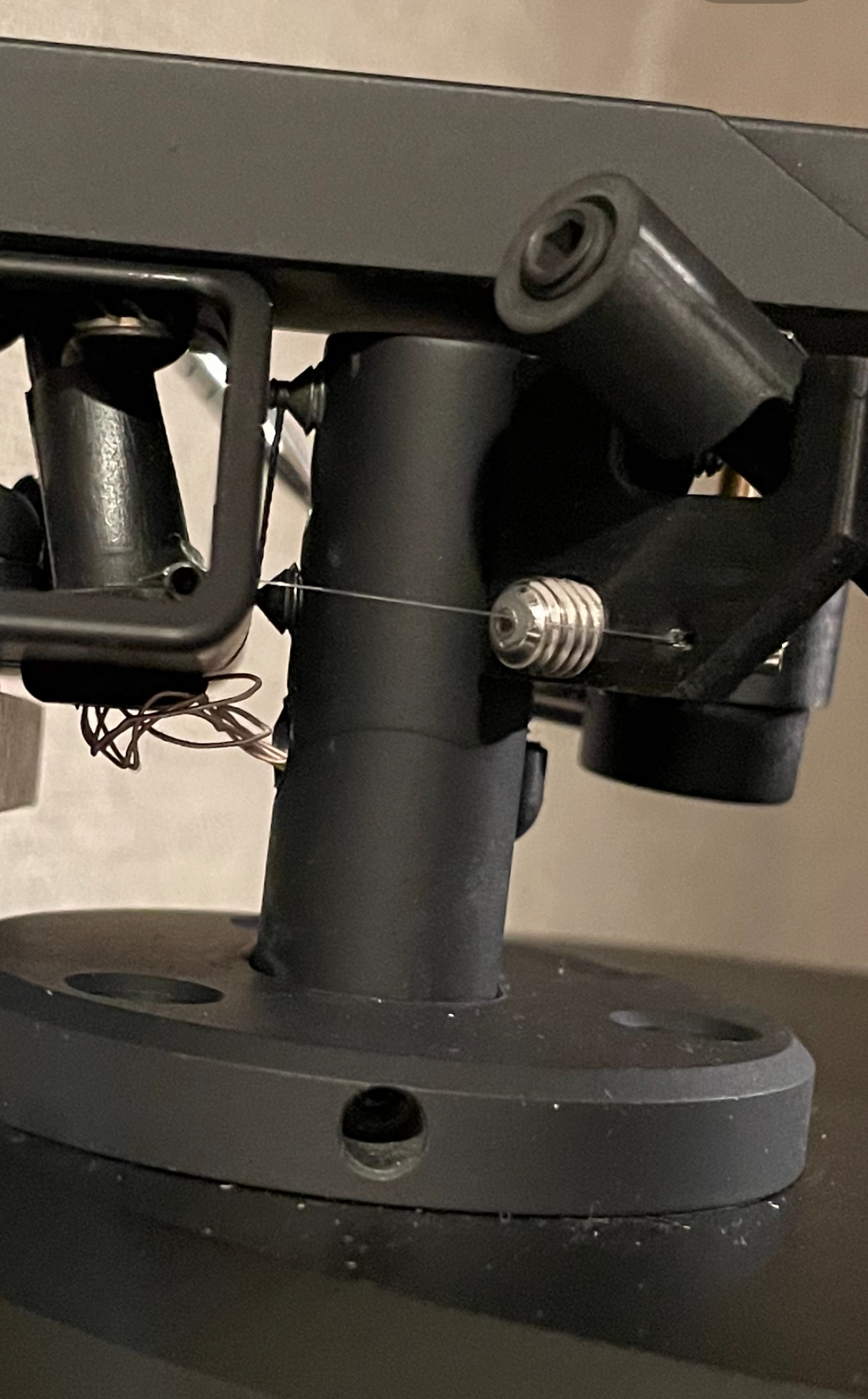
Cylindrical anti-skating "bias rotor" showing hex head bolt you screw outward to increase anti-skating force. In this photo you can easily see the "hoist" at the top of the pillar rear, and below it the pivot point. Though it appears to, the hoist does not touch the thrust box. Only the point does. This mounting platform was not tall enough for my set up needs. I needed a taller one.

This is the taller arm base I ended up using. To the right of the pillar you can see the rubber tipped level control screw touching the base. You can try it both touching and not touching.
The arm came with a DIN jack in the pillar and a DIN to RCA cable. You can order it with your choice of wire in a continuous length from the cartridge clips to either RCA or XLR plugs.
There are also ingenious options for adjusting arm mass should the arm as delivered not produce with your chosen cartridge the ideal 8-12 Hz resonant frequency but I'm not going to get into those here.
One final thing before getting to the Supactrac Blackbird's sonic and mechanics performance: Supratrac recently added a damped cueing device, which also can serve as an arm rest. This is a really useful thing! Especially since the alternative was an "Origami armrest" you bend yourself out of supplied piece of flexible I guess plastic. Here's what it's supposed to end up looking like:
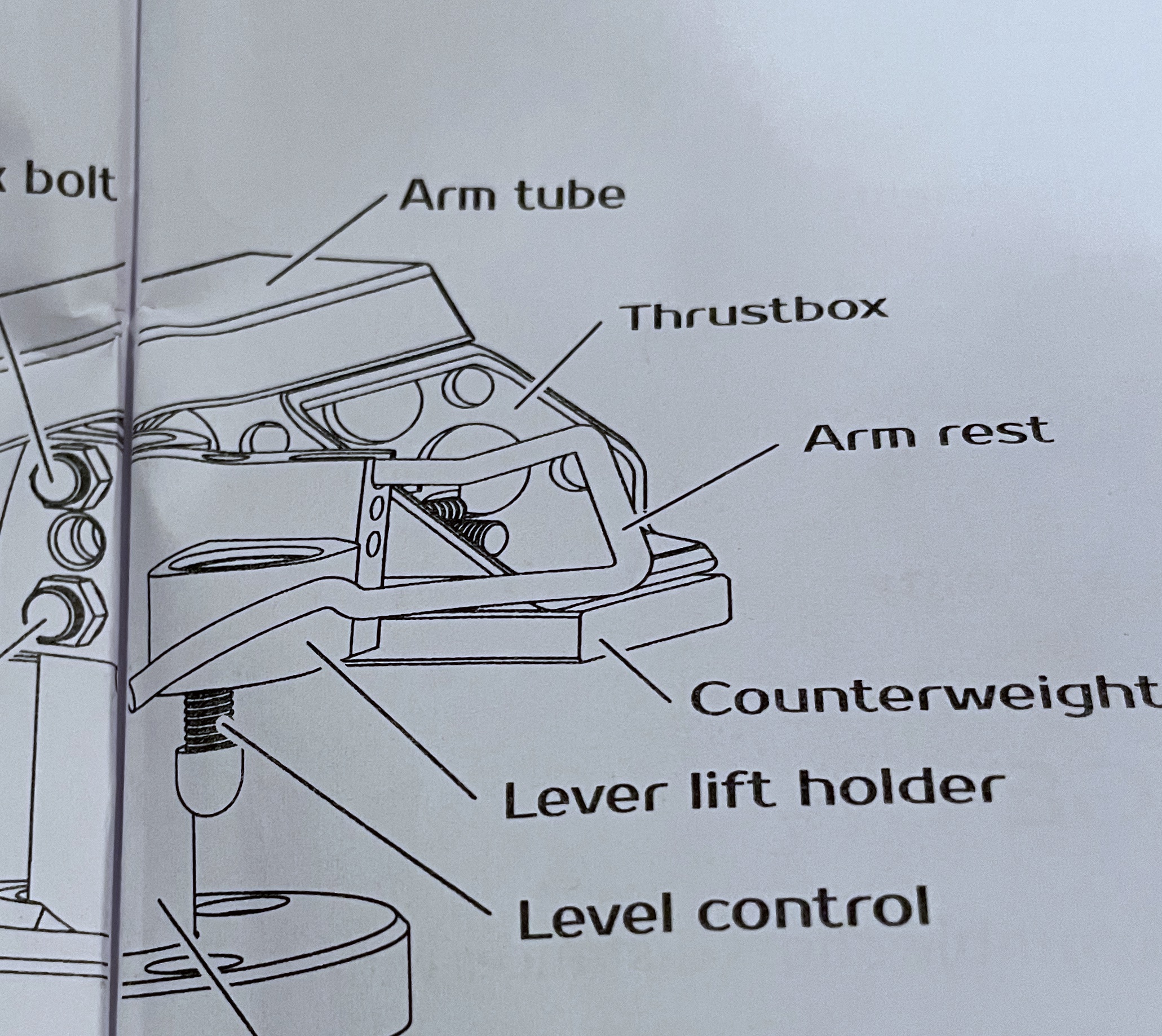
And here's what it starts out looking like. I didn't look closely at it and it wasn't labeled so I thought it was an allen key, but it's bendable! I could never get it bent correctly so I was happy to stick with the cueing system.
I Cannot Get Over It! I Am Totally Addicted to the Blackbird's Sonic Performance
Following a quick double check of everything it was time to play records! I really wondered if I'd done everything correctly and worried about what would happen when I lowered the arm into the lead-in groove of the first record I played, which for some reason I can't figure out was "To Love Somebody" from Bee Gee's First (U.K. Polydor 583012). I've been playing this record since 1967.

I refer you back to the beginning of this review. Incremental "betterness" has been part of my reviewing journey for all these years, only occasionally punctuated by fundamentally better "wow" experiences. Ortofon A90, The Caliburn, Kuzma 4 Point then SAT arms, the Ypsilon VPS-100, the CH P10 and now this, least expensive of all products not "better for the money" but just startlingly better. That was my immediate reaction to the reproduction of this probable four track orchestrated pop/rock recording.
The first thing I noticed was the solid lock as the cantilever touched the record surface. The stylus didn't "settle into the groove". It stuck the landing. So solid I feared the arm wouldn't move laterally at all! And the pre-song quiet was notable. Then it began. It starts with a single bass note then guitar strum, then a kick drum followed by a harp glissando then strings—all laid out and unfolding precisely yet with unforced ease.
Fundamentally better. Those opening bars were like a masterful table setting. Then came the meal. The kick drum, the bass, the snare and especially Barry Gibb's voice just had a "rightness" in time and timbre and an image roundness that just knocked me over.
The horn parts, the strings, the kettle drum, all were just "right". Bass was deep, and I won't say "tight" because it was better than "tight". The kick drum attack was, the word that popped into my mind was "daring". I could feel the softness of the bass drum mallet as it hit the head and the head's hardness followed by decay accuracy and the next hit, so properly deep, textured and well-controlled. I'd never heard it remotely that detailed in time, space, texture, timbre, and however else you might want to describe it—all locked in three-dimensional space.
I realized that everything in the bottom octaves was revealed with exceptional clarity and ease, especially rhythmically and free of any sort of time or amplitude overhang. This is where lesser arms always mess up—in the 100 Hz or so region and what can be heard can also be measured. My previous endeavor didn't do this but the now U.K. parent mag does and if you look there you can find tonearm resonance measurements. The Supratrac arm hasn't been reviewed there or measured but I'm confident if and when it is, that lower range region will be remarkably resonance-free as it was on SME's polymer arm unique to its Model 60 turntable. It's what I heard with that arm when I reviewed the 'table, confirmed by the measurements.
Some of the comments under the original post where I embed the YouTube video that lets people hear the arm (as best as is possible within the limits of YouTube) claim that the sonic signature must only be a result of the arm's resonant signature (or lack thereof). Perhaps that's so, but I think otherwise because this arm's sonic performance is as unique in an uncolored, unforced, non-mechanical way as I've heard from any tonearm. What can be the cause of that?
The unclogged low frequency arteries allowed bass rhythmic expression that was revelatory on every record i played, which is one reason i found myself staying up very late every evening and just pulling out familiar records to hear what showed up. Like on "Most Likely You Go Your Way (And I'll Go Mine)" on Blonde on Blonde. it's a raucous track that the Blackbird expertly laid out rhythmically, putting my in the studio and hearing everything going on at the back of the room in a "oh, that's what that is!" kind of way.
The presentation on the Bee Gee's album placed instruments front to back in space on this relatively simple probably 4 track recording with a clarity and ease that revealed so much previously hidden information but mostly it was the time factor, the way everything locked together with ease that both drew me in and put me at ease as the music effortlessly presented itself locked in time. The OMA surely helped the arm deliver this sensation but the arm was doing much of the heavy micro-time lifting.
It was like the arm was laughing! I know that's nuts but listening to it was like watching a star athlete make the impossible look easy. I've rarely heard vocal sibilants so cleanly, correctly and consistently presented on that album and all of the others I've since played.
The last time an arm flabbergasted me like that was when I first heard the SAT arm on the Continuum Caliburn. Well, here, there is the 12" SAT CF1-12 also mounted on the OMA K3, but on the front arm board, which is of even higher quality (it has the fluid filled damping channels). The arm cost around $67,000 a few years ago. I don't have current prices. It too was plugged into the van den Hul The Grail SX that will be reviewed next here, but instead of the Kleos SL, it had a Atlas Lambda SL, which now costs $14,295(!). So I made a comparison of an around $7500 combo versus one that cost around $83,000!
One thing I realized is that I hadn't played that Bee Gees album in a long time and the rest of my system had for various reasons gotten considerably better and the Bee Gee's album sounded way better than last time I remember playing it some years ago. Nonetheless, the comparison was scary because the less costly combo did so well and some of my visiting friends preferred it.
While the costly combo produced more finely rendered, compacted images on a deeper and wider stage, and there was even greater detail revealed, the Blackbird's bass attack, extension and dynamic slam were, while different from the SAT's more subtle presentation, more persistent, vibrant and "punchier" without sacrificing control, texture or rhythmic authority. Yes, the cartridges were different but the 1/3 the price cartridge was producing unforgettable and addictive results.
Among the tracks I'd auditioned and recorded are in this YouTube video:
i thought a comparison of the two presentations—Supatrac/Kleos SL, SAT CF1-12/Atlas Lambda SL— would be useful so I digitized "Waltz For Debby" from the 45rpm D2D Groove Note double LP set The Bill Cunliffe Trio Live at Bernie's (GRV-1009-DD) recorded in the space outside of Bernie Grundman's mastering suite. Joe Harley produced, Mike Ross engineered. I was there and cannot believe it was twenty three years ago (March, 2001).
Soundcloud isn't exactly "hi-res" but I'm confident you'll hear this just fine, though I'm not going to tell you which is which!
I just received the new Craft OJC reissue of a Riverside 1962 original Know what I mean? (Craft CR00716) featuring Cannonball Adderley and Bill Evans with MJQ bassist and drummer Percy Heath and Connie Kay. My "go to" copy has been a Japanese reissue (SMJ-6051). This reissue cut by Kevin Gray is so much better. Through the Supatrac arm, Cannonball, in three-dimensions is playing in a space you can "see" and hear. Bill Evans is in the right channel, Kay drums to Cannonball's left and Heath's bass sits to the saxophonist's right (so to his left on the soundstage). The program is a combination of standards and originals, including "Waltz For Debby", John Lewis's "Venice" and the title tune written by Evans. "Waltz..." with sax is definitely different but as enjoyable as any version you've heard—or at least that i've heard. Everyone plays "Sotto voce" on "Venice". The Supatrac delivers the micro-dynamics with nimble ease: an impressively well-textured "reedy" saxophone, Heath's fingers plucks, and Kay's always light touch on the cymbals. Black backgrounds emphasize the arm/cartridge's high quality tracking capabilities.
I'll not cite more examples to make the case for this tonearm but you can be sure I played many classical piano records, both solo and orchestral and this arm's ability to track and deliver piano is remarkable.
I'm just telling you that its sonic and mechanical performance are remarkable at any price. First play, the Supatrac hit me upside the head and months later I'm still vibrating. It demands to be heard before you buy any new tonearm. I now have three other new tonearms to review. In Vaudeville they used to say never go onstage after child acts or animal acts. The Supatrac is a child act and an animal act I hope these other arms get on stage and do well because the Suptrac Blackbird is a tough act to follow!
Conclusion
I knew that Mark Döhmann is a big fan of this arm and he's pairing it with his far more costly Helix turntables as well as importing and distributing the arm in Australia. After I'd finally gotten it set up and played the first few memorable tunes I emailed him and said "This arm is ridiculous!". He immediately responded "Do you mean because of set-up difficulties?" I said, "No, but that's true too! I'm talking about how it sounds!" I then went into some of what I've written above and he called me from Australia (it was late night in New Jersey and around mid-day in Melbourne) and we shared our very similar sonic findings and enthusiasm for the arm.
Cleanliness, organization, clarity, sense of musical flow, unrestrained dynamics, bass extension, control and freedom from "overhang", transient delicacy, and especially a complete lack of mechanical artifacts and exceptional "traceability" separate this arm from most others. Every visitor to my room, not fed any pre-digested hype from me you can be sure, every one of them went bonkers! That's the only word to use.
I kept it set up and running for a few months without changing cartridges. Why bother? if it mated well with the Kleos SL it should work with just about any typical MC and what i was hearing was too good to mess with (selfish reviewer). At the end of the review period I went back and double checked all of the settings. Everything, including VTF, anti-skating, SRA, azimuth (with a slight "lean" from perpendicular to achieve excellent and perfectly balanced crosstalk figures) measured as it did when I first set up the arm.
This is not an easy arm to set up so be forewarned, but after having set it up and gone through a steep learning curve, I feel I've got it down. The instructions need an update and more importantly I think a page of just plain prose outlining what needs to be done and why (plus of course telling buyers to remove the transport screw and spacer before telling them how to set the overhang!). The pillar lean when loosening the grub screw was also concerning but these are easily fixable issues.
If you are contemplating getting one remember to take care with the overhang shift if the arm pillar rotates from its original setting, be careful about the stiff tonearm wiring at the clip end, only use a cartridge with a secure stylus guard, experiment with the magnet weights to get that sorted out, get the "hang" of the azimuth adjustment before attempting it, watch for "pillar lean" when you loosen or tighten the base grub screw, and once you've set SRA, double check the azimuth setting. And don't be afraid of the centrally located "finger lift". It's really a great idea! But if need be replace it with the supplied more standard one.
Oh! One more thing. At last year's Munich show i quipped to Mr. Braine that perhaps it would be a good idea to instruct people to wear rubber underwear before their first listen to this arm—and that's after only getting a brief sonic "taste" at the show.
When I opened the carton containing the arm, out popped this:
 Now I thought that was pretty funny and not surprising since Mr. Braine, along with being a very ingenious tonearm designer, has a puckish sense of humor. We definitely hit it off in the humor department at the show so he knew this would in no way offend me.
Now I thought that was pretty funny and not surprising since Mr. Braine, along with being a very ingenious tonearm designer, has a puckish sense of humor. We definitely hit it off in the humor department at the show so he knew this would in no way offend me.
However, Mr. Braine threw me a double whammy because when got to page 13 there was this!
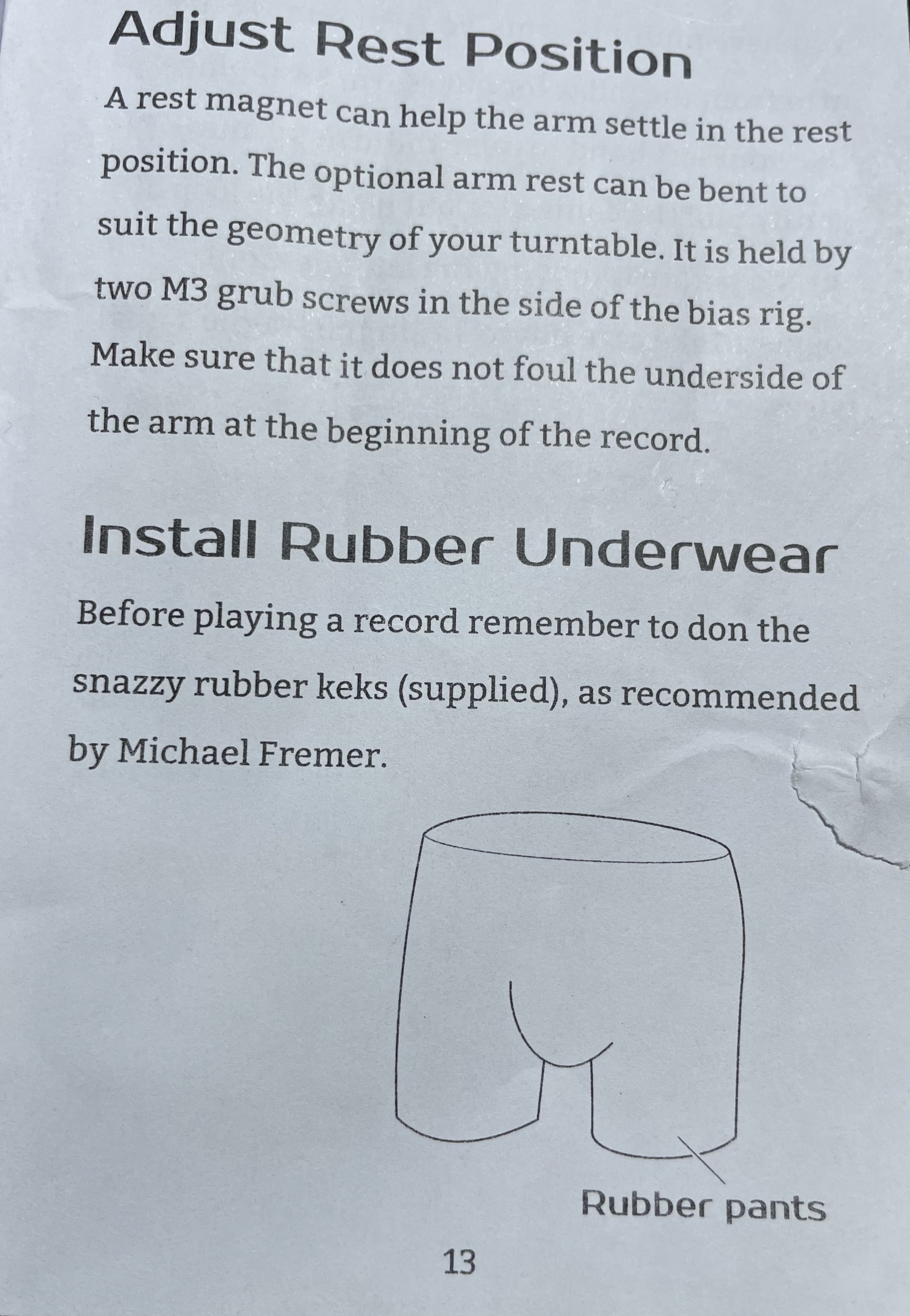 Of course I found that funny too but could that really be in the instruction manual every buyer gets? No! It was a one off strictly for my abusement. What a funny guy!
Of course I found that funny too but could that really be in the instruction manual every buyer gets? No! It was a one off strictly for my abusement. What a funny guy!
I did say I followed the instructions, so before listening I tried them on. I'll spare you the photo but it wasn't bad!
I don't want to end this review with an underwear joke so rather than do that, l'll end with a non-superlative statement, avoiding "game changer" because I hate that cliché. So I'll go with this: the Supatrac Blackbird Farpoint is unique in design, unique in its mechanical interaction with the groove, and unique in its remarkable, effortless and explosive sonic performance. I hope you get to hear one soon.
Specifications
Prices (without VAT):
9" £2416.67
10.5" £2666.67
12" £2916.67
Custom paint color +20%
Custom length +20%
Enquire for overseas shipping prices
By default the internal wiring is 30/0.04mm silk-covered copper litz. If supplied, arm cables come with straight or right-angle DIN connectors as requested.
9" Blackbird has an approximately 10g effective mass (a mass adapter and ballast block can be used to increase compatibility with a wide range of cartridges)
warranty: 5 year conditional warranty (transferrable within the U.K.)



